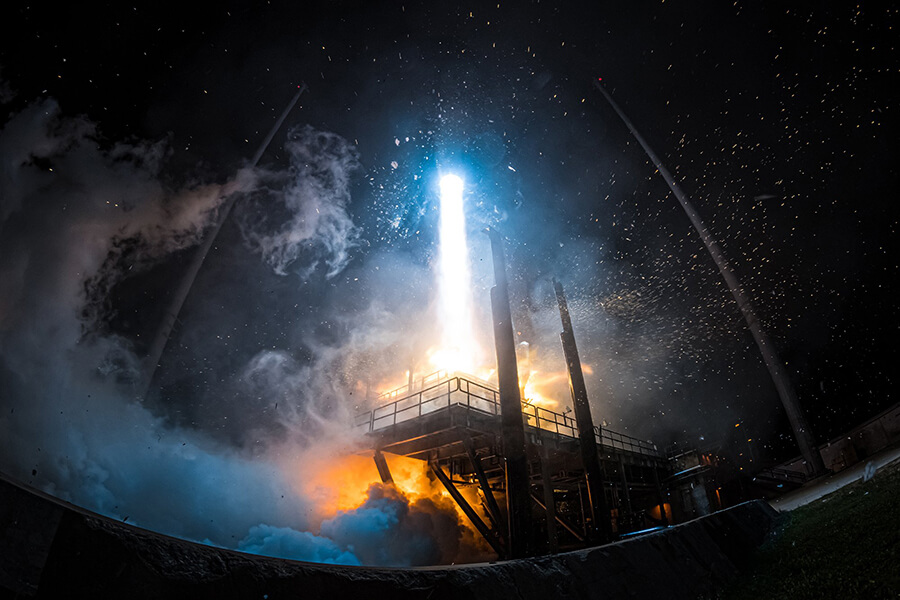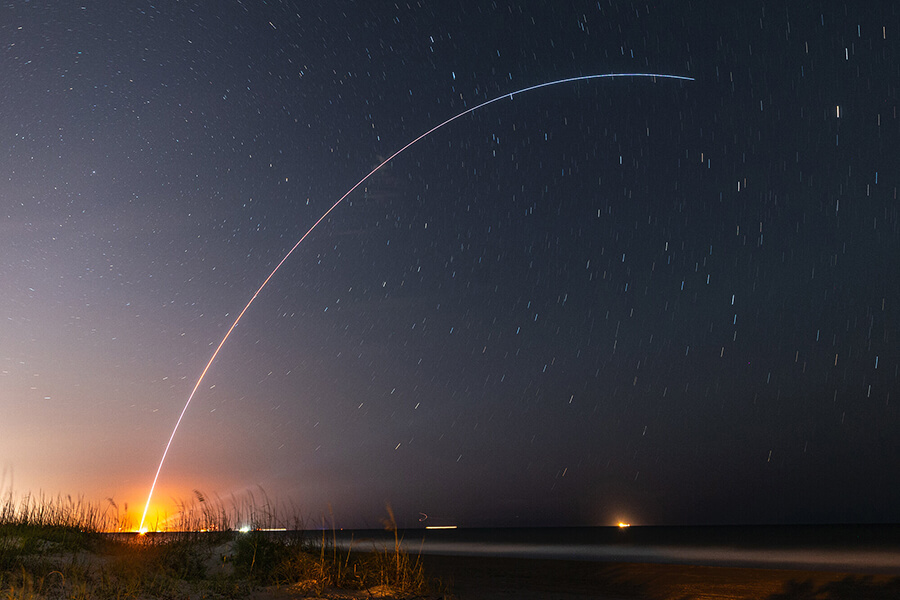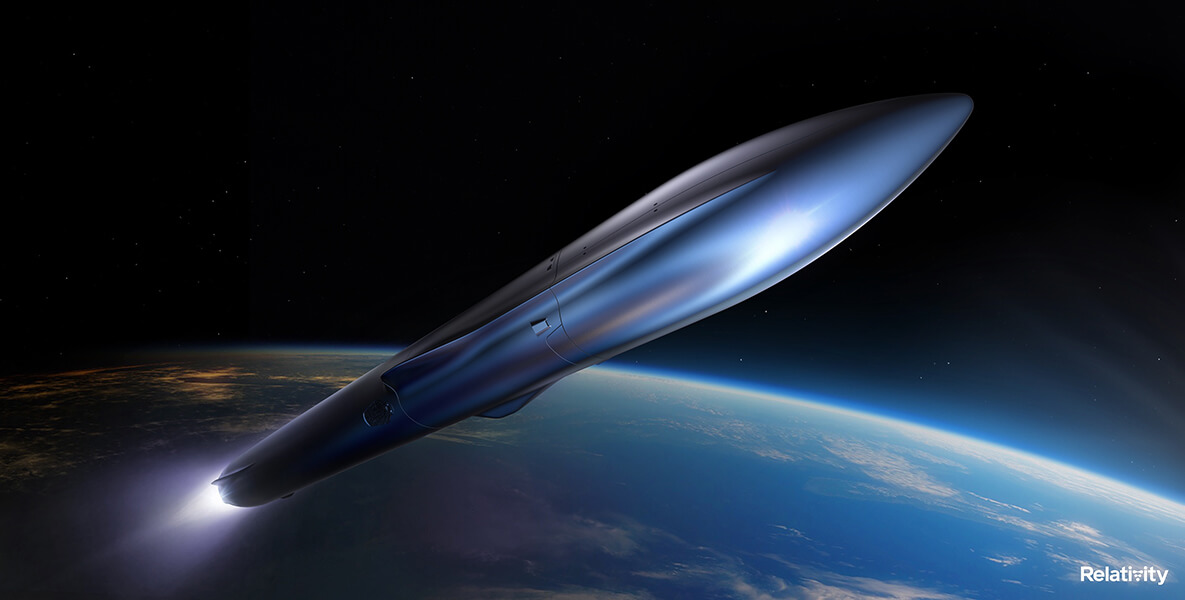The First 3D-Printed Rocket — Created by Trojan Engineers — Reaches Space

reach space.
At 110 feet, Terran 1 was the largest 3D-printed metal object on Earth. And last March 22, after a fiery launch from Cape Canaveral, it was a blue-white streak in the Florida sky.
In a significant milestone for the future of space exploration, Terran 1, created by Relativity Space, became the first 3D-printed rocket to pass the Kármán line, the boundary between Earth’s atmosphere and outer space. It was the culmination of a 12-year journey for Tim Ellis, B.S. ’12, M.S. ’13, and Jordan Noone, B.S. ’14, former leaders of the USC Rocket Propulsion Laboratory and the co-founders of Relativity Space.
Terran 1 — which was 85% 3D-printed — augurs huge changes to the space industry in terms of cost, speed, less waste and design efficiency. The launch, dubbed “Good Luck, Have Fun,” saw the rocket to fly and pass Max-Q, the point of maximum stress on the craft. It was also the first methane-fueled orbital-class rocket to successfully complete stage one flight, main engine cutoff and second stage separation, in the West.
Said Noone: “Relativity’s 3D-printing approach with Terran 1 … draws forward aerospace manufacturing into the digital era. This launch opens the door for all the potential future applications of that development, such as human spaceflight.”
According to Ellis, while traditional rockets use hundreds of thousands or even millions of parts, Relativity’s approach to additive manufacturing unlocks an entirely new value chain enabling radical part count reduction. The company uses cutting-edge 3D-printing methods to produce primary structures — like propellant tanks, thrust structures and the nosecone — as well as smaller, complex parts like the engine thrust chamber assembly.

With a futuristic Model T assembly line, the company anticipates being able to produce 45 of its next-generation Terran R rockets annually from a single factory — with potential for more first- and second-stage components based on customer demand over time.
For this to become a reality, Ellis and Noone not only had to build a rocket, they also had to reinvent advanced manufacturing.
“We had to invent the actual process itself,” said Noone, who left his role as Relativity chief technology officer in 2020 but remains an executive advisor. “It was kind of like building a 3D-printing company and building a rocket company at the same time under one roof — each a very complex thing to do! That was the big bet: Could we do both at the same time?”
First, they had to create the Stargate, the world’s largest metal 3D-printer. The fourth-generation Stargate printers — named after a futuristic technology as imagined in the video game StarCraft — defy traditional printing constraints by moving horizontally rather than vertically.
Even as Relativity builds more rockets, Ellis, the company’s CEO, envisions one day 3D-printing all the machinery that would sustain the first Martian colonists, including “the first rocket made on Mars,” he said.
Ellis and Noone met in 2010 as students at USC Viterbi. “I still remember [Noone] joined USC’s Rocket Propulsion Lab, and I think he wasn’t even 18 yet and said he was going to run the whole lab,” Ellis recalled. “I just thought that level of cockiness and ambition was sort of rare, but he had the talent to back it up! What he promised, he delivered on. USC Rocket Propulsion Lab went on to become the first student group in the world to launch a rocket to space.”
That 2019 launch — the world first’s successful student-built and designed rocket to reach outer space — was but a foretaste of what was to come.

“Jordan and Tim represent the very best of USC — visionary, entrepreneurial and creative,” said USC Viterbi Dean Yannis C. Yortsos. “This first 3D-printed rocket launch is merely the fulfillment of the incredible promise they showed as student leaders.”
After graduation, they would talk on the phone during their commutes to and from work. Noone remembers driving home in his Volkswagen Jetta, sometimes calling Ellis at 2 a.m. He’d be getting off work at SpaceX in Hawthorne, California, while Ellis would be leaving his job at Blue Origin in Kent, Washington.
Both companies had “lukewarm interest” in 3D-printing technology. While many companies used 3D printing for some elements of their rockets, nobody was thinking about it quite on the scale of Ellis and Noone.
At SpaceX, Noone recalls, the rule companywide was, “no science projects.”
“And 3D-printing development was, admittedly a science project,” he explained. “We’re talking non-trivial, very foundational, scientific physics-level development of the printing process.”
But after a cold email to investor Mark Cuban (subject line: “space is sexy, 3D printing an entire rocket”) netted a half-million-dollar commitment, Ellis and Noone were ready for their science project.
One of the early relics in Relativity lore was the back of a Starbucks napkin, where they sketched out their initial vision of a Martian voyage powered by 3D-printed rockets.
“I always thought [Noone] was a good foil to me,” Ellis said. “He was more of a pessimist and a realist and kind of a stickler for details, and that was very helpful in formulating our early ideas. We balanced each other.”
That balance eventually led to the birth of Relativity Space, which has already presold an enviable $1.8 billion in space launches. With this launch, Relativity moves forward with Terran R, a reusable, 3D-printed, medium-to-heavy lift rocket. The company is valued at $4.2 billion.
In July 2022, Relativity announced its first commercial mission to Mars in partnership with Impulse Space. With an anticipated launch window in 2026, the historic partnership advances both companies’ shared goal of a multiplanetary existence for humanity. Relativity’s role: to launch Impulse’s Mars Cruise Vehicle and Mars Lander in Terran R from Cape Canaveral.



